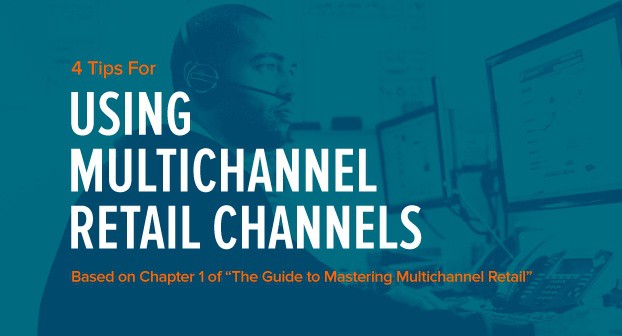Mastering Multichannel Retail can be difficult and it’s much more of a challenge to focus on several sales channels instead of just one. You risk the chance of losing control of your inventory levels, finding it difficult to manage orders, or forgetting about your brick and mortar store.
However, in order to have the most successful business possible, multichannel selling is the key to increasing sales by reaching a much wider consumer audience. For example, Amazon has approximately 500 million visitors per month and eBay has around 285 million visitors each month.
By selling on online marketplaces, you can increase the number of people who have visibility of your products and in turn increase revenue. According to the Wall Street Journal, new marketplace sellers often see a 50% increase in overall revenue when they sell on Amazon, who would turn down the opportunity to increase revenue by 50%?
We’ve created ‘The Guide to Mastering Multichannel Retail’ to offer the best advice and tips on multichannel selling and how to avoid those dreaded and often too common multichannel mistakes. This blog takes a look at Chapter 1 of the guide which focuses on the best ways to succeed when selling on multiple channels including how to manage multichannel orders from a single place, synchronizing inventory levels, optimizing your best sales channels and how online and brick and mortar can compliment each other.
Here’s a breakdown of our 4 top tips in order to achieve success in the multichannel world…
1. Manage Multichannel Orders From a Single Place
As soon as you begin selling on multiple channels, it can get difficult to manage the volume of orders from various different selling points. As your retail business and orders both grow, managing these orders across multiple channels becomes less manageable and it’s time to come up with a solution to save you time and make managing your sales channels easier to handle.
Imagine trying to keep track of your hundreds or even thousands of orders across your website, brick and mortar store and multiple marketplaces. Do you think it sounds like a difficult challenge? It can be challenging and ultimately takes a lot of time and effort which I bet you don’t have?
There’s a solution: manage all of these orders from one single place. Use order management software that automatically collects orders from different channels and places them into one single interface. There you can efficiently manage and fulfill them!
When going multichannel, you risk the chance of double selling, making accountancy errors, losing track of orders and slowing down delivery times (some marketplaces will penalise for this so be careful!). Automation is the answer to all of your problems! Having software that automatically pulls through all your orders into one channel, updates your inventory levels across all channels and creates accounting journals, will save you a lot of time usually spent manually processing.
A great example of a retailer marketing across multiple channels is Pawstruck, who sell natural dog treats. In this interview with Web Retailer, Kyle Goguen, founder of Pawstruck talks about their business across their own website, eBay and Amazon and how they manage to keep in control of orders from all of these channels. Kyle discusses how using retail management software makes it easier to easy stay in control of orders, he said “We’re able to focus on other things as opposed to managing many different channels at once.”
2. Synchronize Inventory Levels
Taking an order for an item which is no longer in stock can be a retailer’s worst nightmare. You miss the opportunity of a sale, spend too much time putting it right and most likely lose your relationship with the customer. When selling on multiple channels, double selling becomes even more likely if your inventory levels are not synchronized.
If you are forced to cancel a customer’s order due to inaccurate inventory levels, you are very likely to lose the customer’s loyalty. Globally, the average value of a lost customer costs $243, according to Kissmetrics. That’s profit you can’t afford to lose!
The solution is to get ahead of the game and automate your inventory levels. Automating inventory levels will reduce the chance of double selling as your inventory levels across all your sales channels will be accurately represented and adjusted as products are sold on each channel.
Synchronizing your inventory levels is easier than you may first believe. The easiest way is to use inventory management software which will save you time and remove the possibility of double selling.
3 things you should automate when it comes to inventory
- Automate the updating of inventory levels
- Allocate inventory to orders as they come in and send triggers to update all channels
- Make sure newly delivered inventory immediately triggers updates to the channels
3. Optimize Your Business’ Best Channels
With over 700 million items available on eBay and 877 million on Amazon, there’s a huge amount of competition on online marketplaces. The first step to getting noticed on marketplaces like eBay and Amazon is understanding how they rate products and suppliers.
Ratings, reviews and delivery options all come into the mix when dealing with eBay and Amazon’s search technologies. Whether it’s product or seller reviews, they are crucial in order to get placed high on the listings page. Looking back to tip number two, avoid stock outs by synchronizing your inventory levels as marketplaces heavily penalise sellers for cancelling orders. Additionally, you can be penalised for not reaching your guaranteed delivery time so set realistic expectations for the safe arrival of each order.
Focus on optimizing the channels that work best for your business first. If you sell much more onAmazon than you do on eBay, it’s probably wise to focus on your Amazon listings, rather than wasting time, money and effort into a marketplace that produces less profit. Once you’ve mastered one marketplace, you’ll have more time to focus on improving your lower performing marketplaces.
4 ways to optimize your online marketplace channels
- Avoid cancelling sales, you don’t want to get penalized
- Offer the right delivery times and stick to your guaranteed delivery time
- Build your seller rating by offering great customer service and speedy communications
- Ask for reviews from your customers
4. Don’t Forget Brick and Mortar
With all this focus on your online sales channels, don’t forget about your brick and mortar store. It can be one of the most important sales channels as you are able to have a face-to-face interaction with the customer. There’s a perfect multichannel solution, don’t treat your online and brick and mortar stores as separate operations and get your sales channels working together.
Take advantage of your brick and mortar store to boost online sales and use your website to influence in-store purchases. It might surprise you that they both have an impacting influence on each other. According to data from Retail Next, 22% spend more at the store if digitally influenced and 55% of online shoppers would prefer to buy from a merchant with a physical store presence over an online-only retailer. These statistics reveal important links between on- and off-line sales channels that will help to grow your business.
Whether you’re selling online or in store, customers will not differentiate between the two, they are likely to treat your online and offline operation as one. This makes it even more important to join up both journeys.
How you can create a seamless relationship between channels:
- Offering a click and collect service for online orders
- Allowing returns to your store so it’s as easy as possible for the customer
- Make your brick and mortar staff aware of online operations; special offers, return policies and stock levels so if you’re out of stock in store you can create an online sales order
- Show stock levels online, if a customer knows it’s in stock, they’re more likely to visit your store rather than ordering online.
For more great advice on achieving multichannel success download the free ‘Guide to Mastering Multichannel Retail’.




